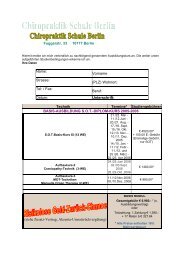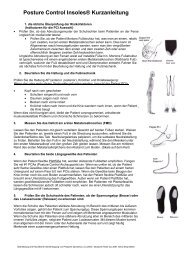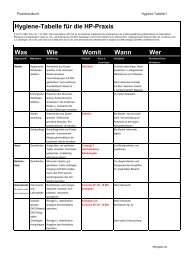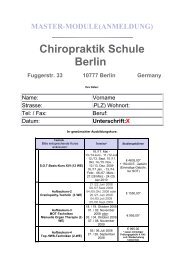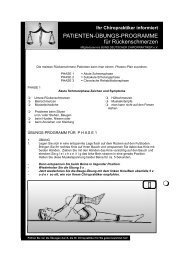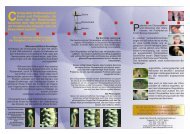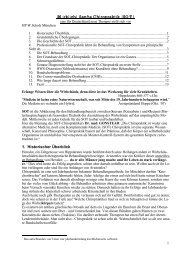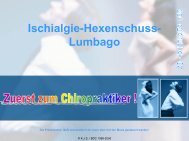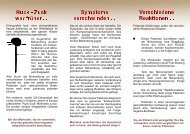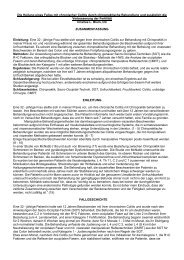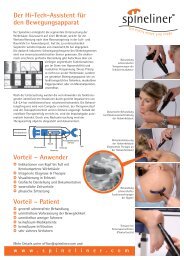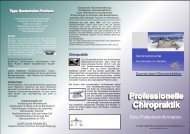TECHNIQUE
TECHNIQUE
TECHNIQUE
You also want an ePaper? Increase the reach of your titles
YUMPU automatically turns print PDFs into web optimized ePapers that Google loves.
Lovett Brothers: The Relationship Between The Cervical and Lumbar Vertebra.<br />
<strong>TECHNIQUE</strong><br />
Lovett Brothers: The Relationship Between<br />
The Cervical And Lumbar Vertebra.<br />
ABSTRACT<br />
Introduction: For years, chiropractors have used the term<br />
“Lovett Brothers” to describe the relationship between specific<br />
vertebra in the lumbar and cervical spine.<br />
Purpose: This paper seeks to investigate the rational behind<br />
this “Lovett Brother” relationship and present possible theories<br />
for its existence. These theories vary from fascial and myological<br />
interrelationships, referred pain patterns, and facilitating<br />
tonic neck reflexes involving intersegmental spinal pathways.<br />
Introduction<br />
The chiropractic profession since the early 20 th century has<br />
incorporated the theory that there is a relationship between the<br />
lumbar and cervical vertebra and has used this concept with its<br />
methods of evaluating and treatment. This concept has empirically<br />
been accepted by chiropractors for decades and was based<br />
on the work of Robert W. Lovett. 1 Walther notes that, “The<br />
spine appears to function with a specific harmonious movement<br />
as an individual walks, runs, and otherwise performs daily<br />
activities… The vertebra working in conjunction with each other,<br />
such as the 1 st lumbar and 5 th cervical, are known as Lovett<br />
Brothers” 2<br />
As the name Sacro Occipital Technique (SOT) implies,<br />
DeJarnette a chiropractor and osteopath, found a relationship<br />
between the sacrum and occiput, as well as between the cervical<br />
and lumbar vertebra 3 . He described that a relationship exists<br />
between the atlas and the 5 th lumbar vertebra, axis and the<br />
4 th lumbar vertebra and so forth, following that pattern all the<br />
way to the mid thoracic region. He called this relationship R +<br />
C factors (for resistance and contraction ) and found that each<br />
vertebra within a pair affected one another.<br />
These concepts have been readily used, are broadly accepted<br />
in the field of chiropractic and there are some theories as to<br />
why this relationship exists. They vary from fascial and myological<br />
interrelationships, referred pain patterns, and facilitating<br />
tonic neck reflexes involving intersegmental spinal path-<br />
Charles L. Blum, DC, Private Practice<br />
1752 Ocean Park Boulevard, Santa Monica, California 90405<br />
Charles L. Blum, DC<br />
Discussion: While there have been no definitive studies evaluating<br />
the use of “Lovett Brothers” as a diagnostic and treatment<br />
modality there have been some reported case studies which<br />
support its use.<br />
Conclusion: Future research is necessary to further understand<br />
this phenomenon that is already readily accepted in the chiropractic<br />
profession.<br />
Key Words: Chiropractic, Sacro Occipital Technique, Lovett<br />
Brother, Applied Kinesiology, Upper Cervical, Subluxation<br />
ways. Apparently “Lovett Brother” relationships can affect or<br />
be affected either in a cervical to lumbar caudal direction or<br />
lumbar to cervical cephalad direction. That would mean trauma<br />
to a lumbar vertebra would also affect its cervical component<br />
and trauma to a cervical vertebra would affect its lumbar component.<br />
Fascial Relationships<br />
The dura mater is a tough fibrous membrane. It is the outermost<br />
covering of the brain and the spinal cord. The dura of the<br />
brain and that of the spinal cord are similar and continuous with<br />
one another at and through the foramen magnum. The dura<br />
mater is the outermost envelope of the central nervous system,<br />
however within the cranium, aside from surrounding the cerebrum<br />
and cerebellum, the dura mater also compartmentalizes<br />
each structure and separates them from each other and the right<br />
from the left side. The external layer serves as the internal periosteum<br />
for the cranial bones and is continuous through the<br />
sutures with the periosteum of the external surface of the skull<br />
where it anchors and attaches itself. The internal meningeal<br />
layer has four folds; the falx cerebri, the tentorium cerebelli,<br />
the falx cerebelli, and the diaphragma sellae. The dura anchors<br />
strongly to the different areas of the inner cranial vault especially<br />
where the meningeal layer comes in contact with the periosteal<br />
layer. 4-14<br />
The cranial dura is firmly adherent to the different points<br />
within the cranium, to the ring of the atlas and extends as the<br />
spinal dura having firm attachments to the foramen magnum,<br />
J. Vertebral Subluxation Res. - JVSR.Com, April 12, 2004 1
second and third cervical vertebrae. The posterior cervical epidural<br />
ligaments anchor the posterior dura mater to the ligamentum<br />
flavum. 15<br />
A connective tissue bridge also has been noted between the<br />
rectus capitis posterior minor muscle and the dorsal spinal dura<br />
at the atlanto-occipital junction. 16 Continuity was also “observed<br />
between the ligamentum nuchae and the posterior cervical spinal<br />
dura as the latter passed deeply from the midline toward the<br />
dura, but only at the first and second cervical vertebral levels.<br />
The ligamentum nuchae also passed bilaterally on to the occipital<br />
bone as far as the sutures between the occiput and the<br />
temporal bones, approaching the inferior nuchal line superiorly.”<br />
17<br />
Along the spinal canal towards the lumbar area, meningovertebral<br />
ligaments (ligaments of Hofmann) have been located<br />
between the L5/S1 intervertebral level cephalad to T1. These<br />
ligaments appear to be more prevalent in the lumbar vertebral<br />
column but are also present throughout the thoracic vertebral<br />
column. It is theorized that the dural sac attachments to the posterior<br />
aspect of the vertebral bodies and the posterior longitudinal<br />
ligament could act to traction the dural sac in the event of<br />
nuclear bulge or herniation. 18<br />
Due to these dural, ligamentous, and fascial connections,<br />
tensions at either end of the “dural tube,” which connects to the<br />
sacrum and foramen magnum, could reflexly affect one another.<br />
This concept is illustrated by holding a relatively inflexible tube<br />
with both hands and stabilizing one end and twisting the other.<br />
The tension that is applied to the twisted end would also be felt<br />
at the other end which is being stabilized.<br />
Sutherland an osteopath developed and researched methods<br />
of evaluation and treatment relating to the relationship between<br />
the cranium and sacrum. He described a relationship between<br />
spinal and cranial meninges and called this relationship the reciprocal<br />
intraspinal membranes. This relationship related the<br />
cervicocranial aspects of the dura with the lumbosacral dura.<br />
Sutherland theorized, “ The intraspinal membranes enable the<br />
cranium and sacrum to function in unison. Therefore, just as<br />
the cranium can affect the sacrum or spine, the sacrum can affect<br />
the spine or cranium.” 19<br />
Myologic Relationships<br />
The multifidus muscles extend from C4/5 to S4 with insertions<br />
from C2 to L5 and has a very complicated structure.<br />
Dvorak and Dvorak describe the muscle’s function: “Bilateral<br />
contraction results in extension of the vertebral column, and<br />
unilateral contraction results in rotation of the vertebral column<br />
to the opposite side.” The affect of this muscle is theorized<br />
to affect the distal ends of the spinal column and could act<br />
as a functional and spondylogenic unit. 20 Chronic lumbar<br />
myofascial contracture could theoretically be implicated in cervical<br />
spine splinting or antalgic positioning.<br />
Referred Pain Patterns<br />
Dvorak and Dvorak also describe some clinical experiments<br />
noting “that local and referred pain occurs upon mechanical or<br />
chemical stimulation of different spinal and paraspinal structures.”<br />
20 “When injecting hypertonic sodium chloride solution<br />
into the paravertebral musculature, ligaments, and apophyseal<br />
joints, or when scratching the periosteum with a needle, local<br />
Lovett Brothers: The Relationship Between The Cervical And Lumbar Vertebra.<br />
and referred pain was elicited in every instance according to<br />
the segmental innervation.” 20-23<br />
On one experiment it was determined that stimulation at the<br />
L1 region created referred pain to the gluteal and inguinal region<br />
and referred pain to the supraspinous, levator scapula and<br />
(anterior and posterior) deltoid regions. 22 Since the levator<br />
scapula muscle has a direct attachment to the lower cervical<br />
spine irritation to this muscle could have a cervical response<br />
over prolonged periods of lumbar vertebra irritation. It is also<br />
not unreasonable to envision an indirect relationship between<br />
the supraspinous and deltoid muscles and the cervical spine<br />
due to antalgic head or neck positioning during upper extremity<br />
physical activity.<br />
Facilitating Tonic Neck Reflexes Involving Intersegmental<br />
Spinal Pathways<br />
Nansel, Waldorf, & Cooperstein, attempted to “determine<br />
whether spinal adjustments, delivered to the upper vs. lower<br />
cervical spine, might result in tonic neck reflex-induced alterations<br />
in the activity of the lumbar paraspinal musculature.”<br />
[24] They noted “lower cervical adjustments induced increases<br />
in tissue compliance (decreases in tone) which were highly significant<br />
(p < .001) and relatively robust compared to those found<br />
following upper cervical adjustments (p < .01).” 24 Results from<br />
this study “indicate that cervical spinal manipulation can have<br />
significant effects on the tone of the lumbopelvic musculature,<br />
presumably by facilitating tonic neck reflexes involving intersegmental<br />
spinal pathways.” 24<br />
This specific study illustrates the Lovett Brother relationship<br />
as a cervical region might affect its companion lumbar region.<br />
What would need to determined in further studies would<br />
be if these “intersegmental spinal pathways” can be associated<br />
with facilitating tonic lumbar reflexes and hence describe a lumbar<br />
to cervical route.<br />
Discussion<br />
The Lovett Brother relationship has been discussed in literature<br />
and proposed as a diagnostic and treatment modality. 25-29<br />
A few chiropractic studies have investigated the relationship<br />
clinically between the effect of treatment to the cervical spine<br />
to the lumbar region. 30-31 Chinappi and Getzoff found a clinical<br />
relationship between the lumbosacral spine and cervicocranial<br />
regions. 31<br />
In the study by Kessinger it was attempted to assess “changes<br />
in spinal motion of the lumbar spine following the correction<br />
of an upper cervical subluxation and compare those results with<br />
the spinal motion of the lumbar spine in a control group that<br />
did not receive upper cervical care. Significant improvement<br />
in lumbar range of motion was noted in both the short- and<br />
long-term range of motion studies within the care group.” 30 This<br />
trend however was not evident in the control group. This study<br />
suggested a positive correlation between an upper cervical subluxation<br />
and the improvement in lumbar range of motion.<br />
Chinappi and Getzoff found that “the position of the jaw,<br />
head and vertebral column, including the lumbar region, are<br />
intricately linked.” 31 Chiropractic treatment to the cervical spine<br />
and jaw allowed the lumbosacral and sacroiliac regions in their<br />
case study to reach greater stability. It was suggested that there<br />
was a relationship between the lumbar spine and cervicocranial<br />
J. Vertebral Subluxation Res. - JVSR.Com, April 12, 2004 2
egion and that this intricate link allows one region to affect the<br />
other. In another study, Gregory found a direct relationship<br />
between the sacroiliac joint and the temporomandibular joint<br />
(TMJ). 32 These clinical findings illustrate a modification of<br />
Lovett Brother relationships and how distal ends of the spine<br />
can influence one another.<br />
Conclusion<br />
The implications of the Lovett Brother relationship allow<br />
for diagnostic evaluation as well as specificity in treatment<br />
modalities. Since one region of the spine can affect a specific<br />
counterpart, evaluating each component of this vertebral relationship<br />
can guide therapeutic application.<br />
Future studies need to evaluate arthritic changes33 in the cervical<br />
or lumbar regions and whether this Lovett Brother relationship<br />
maintains consistency. It would be anticipated that<br />
long-term disuse or trauma to one part of the spine would be<br />
reflected in its associated counterpart. Greater research and<br />
clinical correlations are needed since the Lovett Brother methodology<br />
is integrated into many aspects of chiropractic techniques<br />
and treatment.<br />
References<br />
1. Lovett RW, Lateral Curvature of the Spine and Round Shoulders, P.<br />
Blakiston’s Son & Co.: Philadelphia, PA, 1913: 1-192.<br />
2. Walther, D.S., Applied Kinesiology: Volume I, Basic Procedures and<br />
Muscle Testing, Systems DC, Pueblo, CO, 1981: 67.<br />
3. DeJarnette, M.B., Sacro Occipital Technique Convention Notes 1965 :<br />
Part Two, Nebraska City, NB, 1965: 51-69.<br />
4. Gardner, E, Gray, DJ, O’Rahilly, R, Anatomy – A Regional Study of<br />
Human Structure, 3 rd Edition, Philadelphia, Toronto, London, W.B.<br />
Saunders Company , 1969, 555-60<br />
5. Goss, CM, Gray’s Anatomy of the Human Body , 28 th Edition,<br />
Philadelphia, Pennsylvania, Lea and Febiger , 1966, 882-7.<br />
6. Breig A, Adverse Mechanical Tension in the Central Nervous System,<br />
New York, NY: John Wiley & Sons; 1978: 11-53.<br />
7. DeJarnette, MB, Cranial Technique, self published, Nebraska City,<br />
Nebraska, 1975, 21-37, 106-7, 181-2<br />
8. Upledger, JE, Craniosacral Therapy II: Beyond the Dura, Seattle,<br />
Washington, Eastland Press, 1987, 115-30<br />
9. DeJarnette, MB, Cranial Technique, self-published, Nebraska City,<br />
Nebraska, 1976, 50-2, 105, 200-13.<br />
10. DeJarnette, MB, Cranial Technique, self-published, Nebraska City,<br />
Nebraska, 1979-1980, 1, 8, 41-2, 81-93, 156-9.<br />
11. Upledger, JE, Vredevoogd, JD, Craniosacral Therapy, Seattle, Washington,<br />
Eastland Press, 1983:77-87<br />
12. DeJarnette, MB, Sacro Occipital Technique, self-published, Nebraska<br />
City, Nebraska, 1984 , 2-7, 46-50, 92-100.<br />
13. Magoun HL, Osteopathy in the Cranial Field, 3 rd Edition, Meridian, Idaho:<br />
Sutherland Cranial Teaching Foundation; 1976: 1-72.<br />
Lovett Brothers: The Relationship Between The Cervical And Lumbar Vertebra.<br />
14. Walther DS, Applied Kinesiology, Vol. II, Systems , Pueblo, CO: Systems<br />
DC; 1983: 9-88.<br />
15. Shinomiya, K, Dawson, J, Spengler, DM, Konrad, P, Blumenkopf, B,<br />
An analysis of the posterior epidural ligament role on the cervical spinal<br />
cord. Spine , September 1996, 21(18): pp. 2081-2088.<br />
16. Hack, GD, Koritzer RT, Robinson WL, Hallgren RC, Greenman PE,<br />
Anatomical relation between the rectus capitis posterior minor muscle<br />
and the dura mater. Spine , December 1995, 20(23): pp. 2484-2486.<br />
17. Mitchell, B, Humphreys, BK, O’Sullivan, E, Attachments of the<br />
ligamentum nuchae to cervical posterior spinal dura and the lateral part of<br />
the occipital bone, Journal of Manipulative and Physiological<br />
Therapeutics, March/April 1998, 21(3).<br />
18. Bashline, SD, Bilott, JR, Ellis JP, Meningovertebral ligaments and their<br />
putative significance in low back pain, Journal of Manipulative and<br />
Physiological Therapeutics , Nov-Dec 1996, 19(9): pp. 592-6.<br />
19. Sutherland WG, Contributions of Thought, Meridian, Idaho: Sutherland<br />
Cranial Teaching Foundation, 1967.<br />
20. Dvorak J, Dvorak V, Manual Medicine: Diagnostics, Thieme Medical<br />
Publisher, Inc.: New York, NY, 1990: 53,253.<br />
21. Kellgren JH, Observations of referred pain arising from muscles, Clin<br />
Sci 1939; 3: 175.<br />
22. Kellgren JH On the distribution of pain arising from deep somatic<br />
structures with charts of segmental pain areas Clin Sci 1939; 3:35.<br />
23. Lewis T, Kellgren JH Observations relating to referred pain viscero-motor<br />
reflexes and other associated phenomena Clin Sci 1939;4:47<br />
24. Nansel, D.; Waldorf, T.; Cooperstein, R.; Effect Of Cervical Spinal<br />
Adjustments On Lumbar Paraspinal Muscle Tone: Evidence For<br />
Facilitation Of Intersegmental Tonic Neck Reflexes Journal Of<br />
Manipulative And Physiological Therapeutics. 1993 Feb ; 16(2): 91-5.<br />
25. Farmer, JA, Blum, CL, Dural Port Therapy Journal of Chiropractic<br />
Medicine Jun 2002;1(2): 54-61<br />
26. Blum CL, Chiropractic and Pilates Therapy for the Treatment of Adult<br />
Scoliosis Journal of Manipulative and Physiologic Therapeutics May 2002;<br />
25(4):<br />
27. Blum CL, Incongruent sacro-occipital technique examination findings:<br />
Two unusual case histories. Proceedings of the ACC Conference IX,<br />
Journal of Chiropractic Education Spr 2002; 16(1): 67.<br />
28. Blum, CL, Spinal/Cranial Manipulative Therapy and Tinnitus: A Case<br />
History Chiropractic Technique Nov 1998; 10(4): 163-8.<br />
29. Hochman JI, Analysis of the Cervical Spine, Today’s Chiro, Jul/Aug 1992;<br />
21(4): 15-20.<br />
30. Kessinger RC; The Influence of Upper Cervical Specific Chiropractic<br />
Care on Lumbar Range of Motion Chiropractic Research<br />
Journal. 2000 Fall; 7(2): 80<br />
31. Chinappi, AS; Getzoff, H; Chiropractic/Dental Cotreatment of<br />
Lumbosacral Pain With Temporomandibular Joint Involvement Journal<br />
of Manipulative and Physiological Therapeutics. 1996 Nov; 19(9): 607-12.<br />
32. Gregory, TM. Temporomandibular Disorder Associated with Sacroiliac<br />
Sprain Journal of Manipulative and Physiological Therapeutics May<br />
1993; 16(4): 256-65.<br />
33. Berkson DL Osteoarthritis, chiropractic, and nutrition: osteoarthritis<br />
considered as a natural part of a three stage subluxation complex: its<br />
reversibility: its relevance and treatability by chiropractic and nutritional<br />
correlates. Med Hypotheses 1991 Dec;36(4):356-67.<br />
J. Vertebral Subluxation Res. - JVSR.Com, April 12, 2004 3



